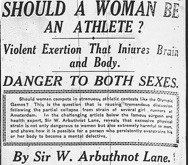Guest Blog by Dr Pria Krishnasamy
The UK trainee perspective (The BJSM blog features the trainee perspective every two weeks)*
As I edge closer to the crossroads of my own career, I muse aloud as to where Sport and Exercise Medicine (SEM) is heading? Is the majority of our workload going to involve musculoskeletal medicine or should the young generation coming through break free from the current mould and realize the vision of Exercise Medicine that the Faculty (FSEM) have fought so hard to promote and to what our specialty owes its existence? I feel the urge to answer the call of cynics …

It is hard to believe bygone statements like these (in the caption) in current times. However, I should say that Sir William Arbuthnot Lane started promoting exercise, fruit and vegetables and bran cereal as an answer to bowel problems in 1925, a good 40 years ahead of his time. We now know that exercise should be undertaken at a sufficient intensity to make one at least moderately breathless. Those who have gradually built endurance over time can be encouraged to perform vigorous intensity activity. My mission is to spread the word of exercise and share a way in which SEM will develop.
“My Best Move” is a pilot project to encourage exercise prescription in primary care for long-term conditions. The project was initiated to help Department of Health (DoH) recommendations to be translated into primary care practice. General guidance is sometimes just not enough and physical inactivity remains one of the five big risk factors for long-term conditions equal in importance to smoking, obesity and hypertension. Since its introduction, the project has been greeted with much enthusiasm in the primary care sector and the extra boost and guidance in the form of training is being welcomed. It is hoped that this will start a new wave in the community that will lead to more active lifestyles despite any chronic conditions that individuals may have, without them feeling hindered by their conditions.
Taking this vision forward, an Exercise Center of Excellence is needed. A place where both able bodied and persons with disabilities, no matter what long term conditions they have, are able to be seen and given specialist care to enable them to live life to the fullest. By tailoring individual exercise prescription and rehabilitation according to patients needs, the aim is to enhance quality of life, improve absenteeism and return individuals to work, which will reap significant economic gains.
Everyone needs to start taking ownership of their own health and start making small gains rather than relying on the policymakers, the health service or their doctor. The gains, after all, are to one’s own health and well-being.
****************************************************
Dr Pria Krishnasamy is a Sport and Exercise Medicine Registrar in London and enjoys long walks in the countryside, martial arts, playing tennis, and dinners with good friends.
Dr James Thing co-ordinates “Sport and Exercise Medicine: The UK trainee perspective” which runs every two weeks.